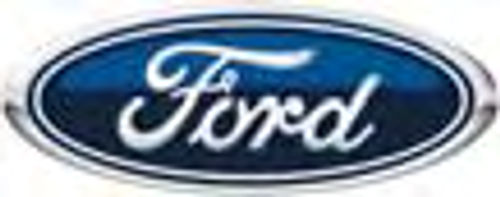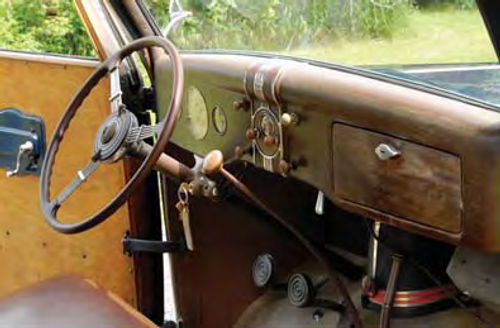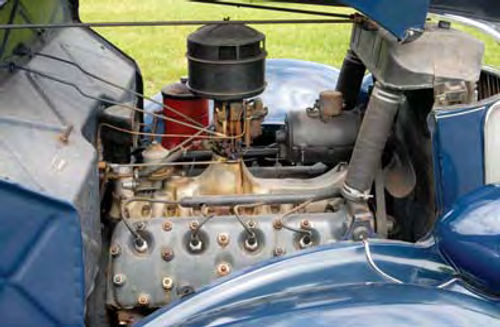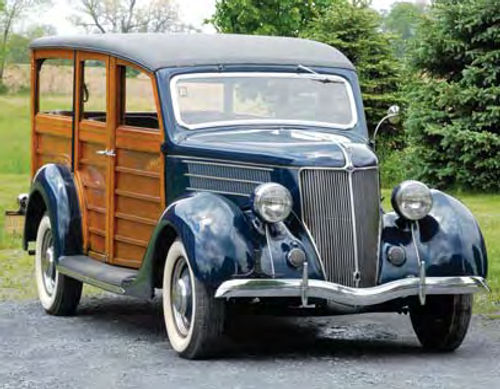1936 Ford Deluxe Wagon

There Are Numerous Reasons Why People Like the ’36 Ford. This Family’s Owned Them for More Than 50 Years.
SEARCHING FOR “1936 FORD” on the Internet can easily generate 10,000 hits. Serious research by telephone, postal mail and word of mouth will almost certainly come up with a lower number, but even if 95 percent of those 10,000 Web sites were to represent duplicates or prove otherwise useless, that would still leave 500 possibilities. Cars don’t become that popular for no reason.
Definitively explaining Ford’s widespread appeal or tracing it to a single factor is impossible, but some of it must date to the Model T. When Henry Ford introduced the T in October 1908, it was a good match for the roads of the day and for the demands placed on a motor vehicle by a world mostly relying on true horsepower.
There’s another consideration, though, and it has as much to do with Henry Ford himself as it does with his cars. Henry Ford was on the eccentric side, but he was somewhere between admired and revered for his personal success, for the Model T’s tremendous impact on transportation and society and, finally, for the fact that he had stood up to the Selden Patent of 1895 which would have required automakers to pay royalties on all vehicles produced. When Ford finally won in court in 1911, he was seen as something of a champion of the little guy and although he no longer was a “little guy,” he was rightfully appreciated for what he had accomplished and some of that feeling undoubtedly spilled over onto his business.
On top of all that, in 1932 Ford took another major step with the introduction of its first V-8.
A V-8 wasn’t exactly the cutting edge in 1932, but in a car selling for around $500, it was important. For example, Oakland’s V-8 that had already come and gone sold for a minimum of $895 in 1931 and when it moved over to Pontiac the following year, the cheapest version at $845 was still far costlier than the Ford.
The new Ford engine was a flathead that displaced 221 cubic inches and generated 65 horsepower. It wasn’t a huge engine and in its initial form it wasn’t without problems, but it had a bit of mystique and plenty of potential; before long, people realized that V-8 Fords were fairly fast cars and with the right modifications could be faster.
That was in addition to Ford’s styling. The Model T really couldn’t be called beautiful, but there was nothing about it that made an owner ashamed to be seen in it. The Model A, which followed the T, gave more than a nod to appearance with its subtle Lincoln qualities, and when it was replaced for 1932, the new car again attached importance to looks. Not wildly different from the A in proportions or general style, one of the most significant changes was that the Model T’s sense of angular flatness, already softened in the Model A, was even less of an element in 1932. The grille shell was slightly rounded at the front to form a vee, for example, while the greenhouse lost a little more of its upright boxiness. But all of that was nothing compared to what Ford had planned for 1933.
A Streamlined Approach
When the 1933 Ford rolled out, it was quite different from its predecessor.
It wasn’t futuristic in the same way that 1934’s Chrysler Airflow or 1936’s Lincoln Zephyr would jump ahead, but the 1933 Ford’s step was long enough that it bore next to no family resemblance to the 1932 and earlier models.
Streamlining was taking hold throughout the automobile industry as it was in other fields and Ford’s interpretation included a wide range of changes.
Its fenders were now skirted on their sides and generally covered more of the tires, particularly up front. What had been a long cowl on the older cars was sharply reduced on the exterior, thus allowing the hood to reach nearly to the base of the windshield. The vee grille continued, but it now leaned rearward and with the headlight bar gone for good, the grille seemed to be between the lights rather than behind them. Sloping hood-side louvers seemed to be pushed back at the top by wind while their bottom line mimicked the slope of the fender.
The 1934 models touched that up somewhat, but the visual changes were minor ones. The V-8 was now producing 85 horsepower and although Ford had continued to offer a four-cylinder, the 1935 models saw only the V-8, which certainly wasn’t a bad choice when combined with the restyled bodies. Less of a clean break than the 1933 Fords had been, their added roundness and just a little bulk helped them to look important. The grille—still veed—now used several horizontal bars across its fine verticals, as did the hood louvers. Fenders covered a bit more of the tires and painted headlight buckets with chromed rims mirrored the theme of the hood and grille.
It just got better for 1936. The immediately noticeable change up front was the grille, which gave up its horizontal bars and changed shape to follow the fender line. Less obvious at a glance was the more crisply pointed hood that the grille’s contour, naturally enough, followed.
A Family Attraction to ’36 Fords


Even people who don’t think of themselves as Ford fans often admit that a 1936 Ford is genuinely appealing.
Style is not the only factor behind the survival of the 1936 Deluxe wagon featured here, but it is a big one and in several slightly complicated ways.
“My dad bought one when he first went to work,” said Jim Hosford, of Nazareth, Pennsylvania, “and I have that car. It’s a phaeton. It was his first work car and like a good person from the Depression, he wouldn’t get rid of anything, so I grew up with that ’36 Ford as a kid. It’s been in the family and I just like them. I like their style.”
His father bought the phaeton in the mid-1950s and drove it as an everyday car until sometime in the early 1960s, when a 1957 Thunderbird (“that’s still in the family today, too”) succeeded it. The phaeton wasn’t simply a cheap car from the back row of a dealer’s lot and even if it had been, other cheap cars available in the mid-1950s would have been more practical. Hosford understands why his father bought it.
“I think what probably got him,” he recalled, “was the lines on the car. I kind of grew up with him saying ‘a ’36, look at the lines’ and he had a pretty good artistic talent, so I think he looked at it from a beauty sense and said ‘OK, that’s what I want.’”
The wisdom of that choice is seen in the fact that his father kept the phaeton and added the woodie.
“I think my dad bought it somewhere in the ’80s,” Hosford said. “I got it around ’93, ’94.”
Hosford knew what to expect because the woodie had been with the phaeton as part of the family, but there was also his own experience with yet another 1936 Ford.
“I even drove one across the country once,” he said. “That was back in the ’70s and it was a two-door sedan. I left with at least one burned valve and probably came home with at least 10 burned valves on it. We went from New Jersey out to San Francisco and then back to Jersey.”
He bought the two-door sedan at Hershey in about 1970, he said, for $900. It was in reasonably good condition—its biggest problem was the 1948 Mercury engine—and seemed ready for a road trip by 18-year-olds just out of high school.
Like most such adventures, flexibility was critical to success.
“I had so many (problems),” he laughed, “you wouldn’t believe it. At one point, I had three flat tires. I had a generator go. The car wouldn’t start on the (starter), so we had to park on a hill and push it. We got pretty good at pushing.”
Is it possible that people might somehow have thought he was crazy?
“I guess so,” he admitted. “We didn’t know any better. That was my true introduction to ’36 Fords.”
1936 Ford Deluxe Wagon
GENERAL
Front-engine, rear-drive, station wagon
ENGINE
Type Flathead V-8
Bore x stroke 3.0625 in. x 3.75 in.
Displacement 221 cu. in.
Compression ratio 6.3:1
Carburetor Two-barrel downdraft
Power 85 hp at 3800 rpm
Torque 148 lb.-ft. at 2200 rpm
DRIVETRAIN
Transmission Three-speed manual
Final drive ration (:1) 4.33
SUSPENSION & BRAKES
Front Transverse leaf spring, solid axle
Rear Transverve leaf spring, torque tube
Brakes (f/r) Drum/drum, mechanical
STEERING
Recirculating ball
MEASUREMENTS
Wheelbase 112 in.
Length 182.75 in.
Height 65.525 in.
Weight 3020 lb.
Tire size 6.00 x 16
Check Those Mechanical Brakes
Burned valves aside, that two-door sedan stayed around until the late 1990s, when Hosford sold it because he knew it was unlikely that he’d ever get the time to restore it.
The wagon’s condition was another matter, as it was already an older restoration when his father bought it.
“The only thing that was pretty bad on it was the mechanical brakes,” he said. “They were bad in the front and they would hang up all the time. It was one side and I ended up taking them apart. Whoever had worked on it before put them back together the wrong way.”
That’s a scary thought and it’s part of Hosford’s first warning about the cars.
“You’ve got to be aware of mechanical brakes,” he explained. “If they’re not adjusted right, not set up right, you can stand on the pedal and pull the emergency brake and you’ll keep on rolling, so you have to be pretty good at anticipating when you’re going to stop. If they’re set up right, they will stop you, so that’s a key point.”
His system for ensuring proper adjustment relies partly on being careful and partly on his long, unpaved driveway. It’s a time-consuming approach, he said, and one that’s worked for him over the years that he’s owned 1936 Fords.
“I think once you have (the shoes) in there and everything’s right,” he said, “it’s a bit of a pain because you’ve got to jack the car up, spin the wheels—at least this is the way I do it—tighten them up, back them off, and take it down the driveway. I live on a gravel driveway. Lock them up and look at which wheel’s setting up first, which one is not setting up, go back, jack it up and take care of it. It’s probably not the 100-percent-correct procedure, but that’s how I got them adjusted.
“You’ve got to be patient. You’ve got to be consistent. When you spin the wheels and you’re tightening them up, make sure that that drag is consistent on all of them.”
Dark Driving & Running Hot
Whether on Fords or other cars, mechanical brakes are often unfairly condemned when they really need only to be adjusted correctly. After that’s been done, they still won’t match the hydraulics on a modern car, but they usually will do their job as long as the driver knows what to expect of them.
The lights are another matter, though, as the combination of a six-volt system with a generator and moderate-output bulbs with not-very-efficient fixtures is enough to get by with, but little more.
“Drive at night,” Hosford said, “and a lot of times, you’d be better off with a flashlight. That’s a real weakness.”
Like the brakes, the headlights require driving with some thought. But beyond that, the news becomes decidedly better. Hosford pointed to the Ford’s engine.
“The flathead’s pretty bulletproof,” he said. “If you go out there and rev the living daylights out of it and you drive it like today’s cars, you’re going to blow it up, but if you’re nice to it, it’s OK.”
Just based on anecdotal evidence— say, the number of flathead Fords seen at nearly any collector car event—that almost has to be true, but there is that nagging question about whether they overheat. Hosford said that in his experience over several decades with several cars, they do indeed run hot. He said that seeing the temperature near the top of the gauge could be disconcerting at first, but emphasized that running hot is not the same thing as overheating.
“They’re not steaming,” he said. “They’re not giving any indication that ‘I’m ready to overheat any second.’ You’d start seeing steam coming out of the overflow tube. I don’t see any of that.”
The strongest evidence supporting his reasoning might be that after all these years, his cars have shown no signs of damage caused by overheating. Less obvious, perhaps, is the thought that if Ford flatheads really do overheat as a rule, it seems hard to explain that so many are on the road and loved dearly by their owners. Finally, it’s even more difficult to understand how an engine with such a serious inherent flaw would have remained so popular for so long that mechanical parts have almost always been available.
Rust Repair Vs. Woodworking
Good support with parts and expertise might be enough to tip the scales in favor of a 1936 Ford, but if not, there’s still that styling. Between those that were restored long ago and others that were rodded or customized, finding a restorable example might take some searching, but fortunately, they’re not extremely prone to rust.
If rust problems do show up, they’re likely to be in the floorboards and running boards, along the door bottoms and below the doors, behind the bumpers and along the lines where fenders meet the body. In other words, they rust in about the same places that most cars of the day rust.
A woodie such as Hosford’s, though, confuses everything. First, it’s obviously going to have less rust than would a conventional car, but the real problem is, of course, the wood body. Its restoration is a job for an experienced specialist or someone willing to invest the time, money and effort to reach the specialist’s skill level. Hosford’s been thinking about that.
“I’ve got one door that’s bad,” he said. “I always think about going out and doing it, but I never do because it’s intimidating. It’s the bottom sill. It’s there, but it’s just barely hanging on by the skin of its teeth.
“That’s probably the most intimidating thing on the car—‘I have to go out and do the woodwork on it.’ That would mean probably going out and buying more tools and polishing up the skills and burning through a lot of blanks before I got it right.”
Next is the matter of cost. A rundown sedan or coupe should be affordable, but a rundown woodie—a really rundown woodie—can be shockingly expensive. Even a car whose wood is useful primarily as patterns can be an eye-opener when it comes to price and although the Ford’s body is not as complex as many other woodies, few pieces will be cheap.
A 1936 Ford, though, needn’t be a woodie to become part of the family. Consider how long Hosford’s been around them.
“Either my dad had one or I had one,” he said, “for almost 55 years.”
A Driver-Friendly Vehicle
Hosford grew up thinking that it was normal to have a 1936 Ford around, so driving one today is no different than it’s ever been for him. Being out on the road in traffic with it, though, requires more than just driving.
“When I take it out,” Hosford explained, “I think the biggest thing I worry about is people running into me. Or the stupid thing is turn signals. You go out there and you do a turn signal that somebody just doesn’t understand. You stick your hand out, ‘I’m going down that road.’ That’s kind of my worry when I take it out.”
That’s certainly not a concern specific to 1936 Fords; anyone experienced with older cars appreciates the value of awareness while driving them. Hosford’s car makes up for that by being so good natured that he’s used it for driving instruction.
“Even if they can’t drive a stick,” he said, “I’ve taught people to drive on ’36s. They’re easy. They’re forgiving. No (firstgear) synchros, so you’ve got to learn how to double-clutch.”
For someone who already can drive a stick, there’s the matter of remembering that the Ford is a three-speed rather than a four-speed.
Putting it in reverse and expecting to move forward can provide a surprise or worse, as can those brakes. Hosford said a competent driver should be able to adapt to his car’s brakes fairly quickly because they’re properly adjusted. It might vary with others.
“If somebody’s never driven one before,” he said, “I always say, ‘Stop the car in the driveway. Put the brakes on. Slam them. Get a handle on them before you get going.
“But once you get used to them, they’re fun cars.’”
Getting Behind the Wheel
That just about says it all—they definitely are fun cars.
Hosford’s isn’t the first 1936 Ford I’ve driven and, oddly enough, my first trip in it came almost two years before I made the photos here. But one constant, and a big part of the Ford’s appeal, is that it is so easy to drive.

Three people in the front seat would be a challenge because it just isn’t that wide, but even for a tall driver, the legroom and headroom are fine. The Ford V-8 always mildly surprises me since, V-8 or not, it really isn’t that big, yet it definitely performs well (and sounds great). Granted that I didn’t try to light the tires or dust a tuner car out on the Interstate, but I have no complaints about how it kept up with traffic or, for that matter, about how it drove. The shifter couldn’t be mistaken for a modern one, but it operated smoothly when handled with care. The steering was as precise as could be expected for a 72-year-old car and at anything but very low speeds, it was actually light. Even the brakes, while calling for some muscle, slowed and stopped the car without dramatics. Hosford was right; someone could learn to drive on this car.
A Real Police Magnet
Hosford was right about something else; the headlights are at best adequate and the taillights barely so. When a friend and I drove the car, we knew we’d be out after dark, so we checked all the lights and found everything working. We were therefore surprised to be stopped around dusk by a local policeman who told us to fix the taillights or park the car. We got out, walked to the rear with the officer, politely pointed to the illuminated taillights and mumbled briefly about six-volt electrical systems. The officer seemed disappointed, but satisfied, while our friends in a 1947 Pontiac wagon, waiting behind us and hoping to see us led away in handcuffs, greatly enjoyed the spectacle. The episode does illustrate that lights on a car like the Ford are nothing like those we’re accustomed to today. Even when working flawlessly, they just don’t match the output of their modern counterparts and while that shouldn’t prevent the car from being driven and enjoyed, it should be kept in mind.
That encounter was the only problem the feature car gave us over two days that amounted to 25-mile commutes…and that raises a question. Is the woodie ready for the same cross-country trip Hosford made in his sedan?
“If we were both 18,” he laughed, “I would probably say about a day of going over it and it’d be ready to go. Going over it is changing the oil, checking the brakes, checking the belts, maybe put a toolkit together, make sure the tires are OK and away we’d go…
“The bigger problem you’d have today is that they’re 50- or 55-mile-an-hour cars. On the highway, you’d kind of have to get used to being beeped at more. I think that would bother me.
“The advantage today is that you’ve got a cell phone. When you broke down back then, you walked or you hoped somebody pulled over and then you still walked. So from that point of view, today would probably almost be easier, a little more stress-free.”
















